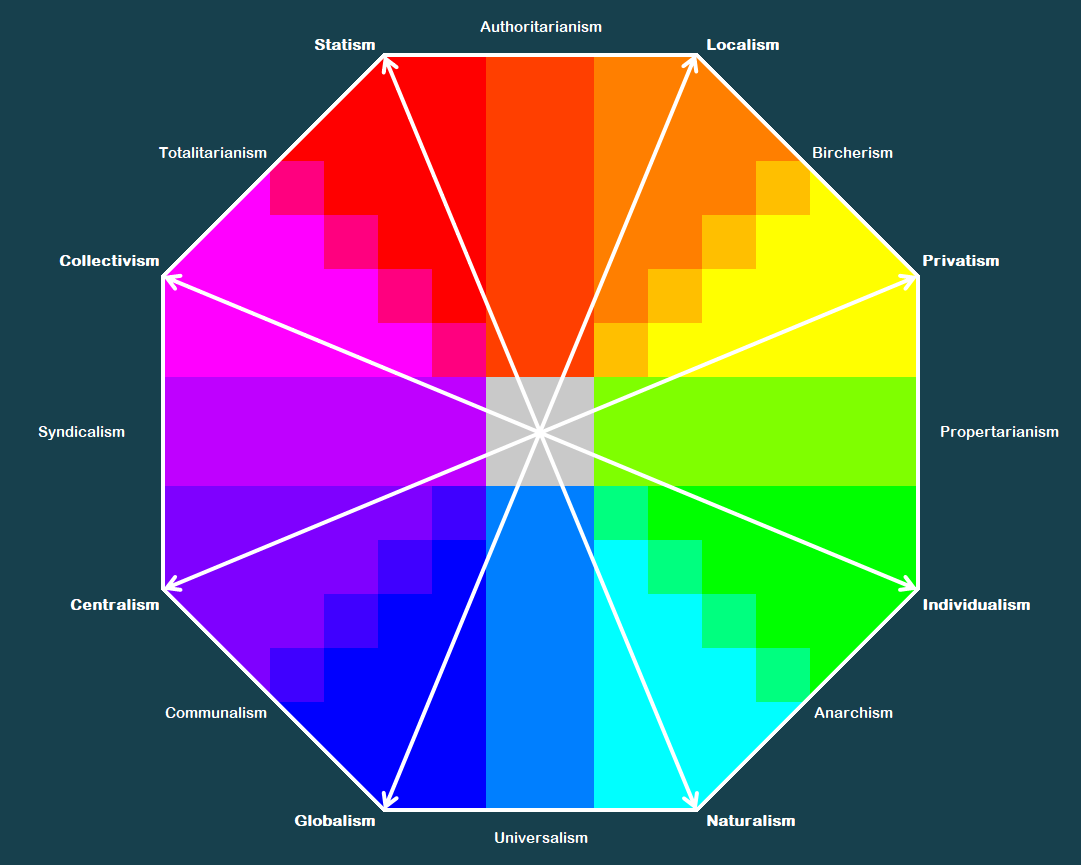
This octagon is the two-dimensional representation of my Four Pillars theory about the categorization of political theory, which argues that each political ideology is indexed on Political decentralization (ranging from Statism to Naturalism), Economical decentralization (ranging from Centralism to Privatism), Social decentralization (ranging from Collectivism to Individualism) and Cultural decentralization (ranging from Globalism to Localism).
Relating this to the one-dimensional political spectrum, the Leftist values are defined as Statism, Collectivism, Centralism and Globalism, and the Rightist values are defined as Localism, Privatism, Individualism and Naturalism.
Localism is the value that advocates for the decentralization of cultural identity.
Privatism is the value that advocates for the decentralization of economical power.
Individualism is the value that advocates for the decentralization of social identity.
Naturalism is the value that advocates for the decentralization of political power.
Statism is the value that advocates for the centralization of political power.
Collectivism is the value that advocates for the centralization of social identity.
Centralism is the value that advocates for the centralization of economical power.
Globalism is the value that advocates for the centralization of cultural identity.
Compatible Leftist and Rightist values can be fused into new values that include aspects of both:
Authoritarianism is the fusion of Statism and Localism.
Bircherism is the fusion of Localism and Privatism.
Propertarianism is the fusion of Privatism and Individualism.
Anarchism is the fusion of Individualism and Naturalism.
Universalism is the fusion of Naturalism and Globalism.
Communalism is the fusion of Globalism and Centralism.
Syndicalism is the fusion of Centralism and Collectivism.
Totalitarianism is the fusion of Collectivism and Statism.
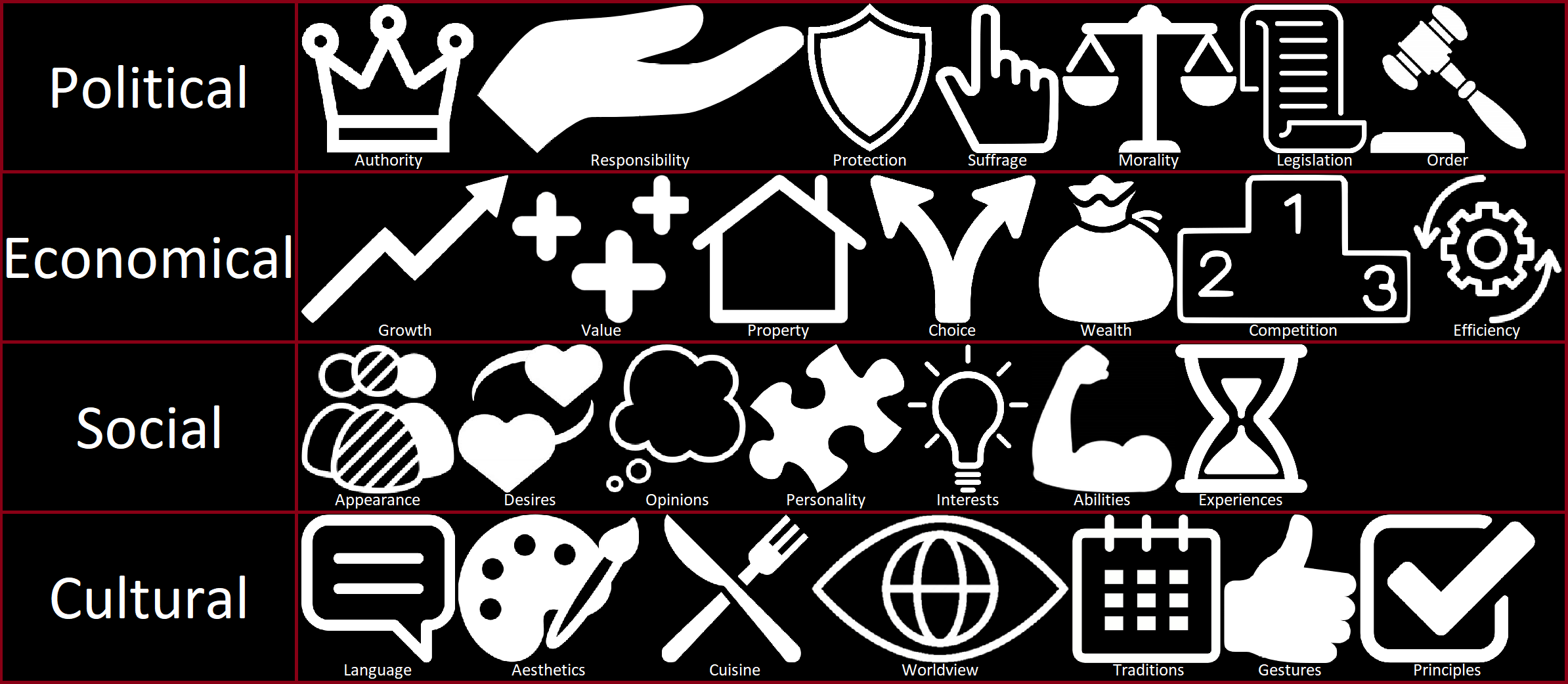
Power structure:
The main aspects of Political power are authority, responsibility, protection, suffrage, morality, legislation and order. Statism advocates for the centralization of political aspects, Naturalism advocates for the decentralization of political aspects.
The main aspects of Economical power are growth, value, property, choice, wealth, competition and efficiency. Centralism advocates for the centralization of economical aspects, Privatism advocates for the decentralization of economical aspects.
Identity structure:
The main aspects of Social identity are appearance, desires, opinions, personality, interests, abilities and experiences. Collectivism advocates for the centralization of social aspects, Individualism advocates for the decentralization of social aspects.
The main aspects of Cultural identity are language, aesthetics, cuisine, worldview, traditions, gestures and principles. Globalism advocates for the centralization of cultural aspects, Localism advocates for the decentralization of cultural aspects.
The eight Octagon scales, which includes the four main scales and the four fused scales:
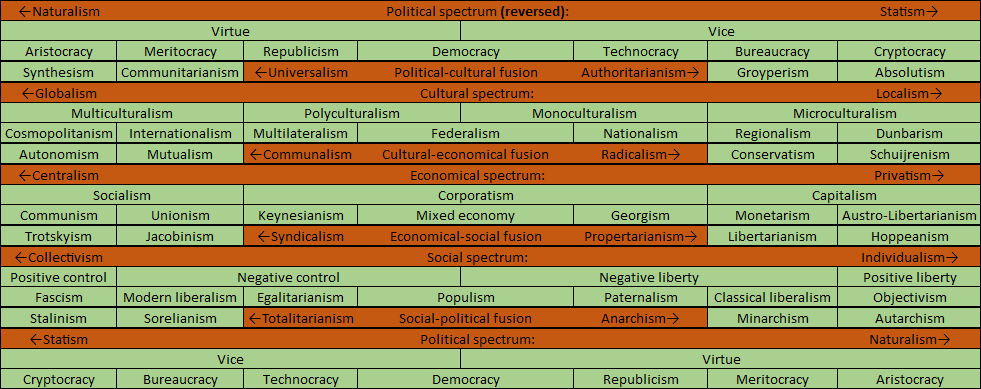
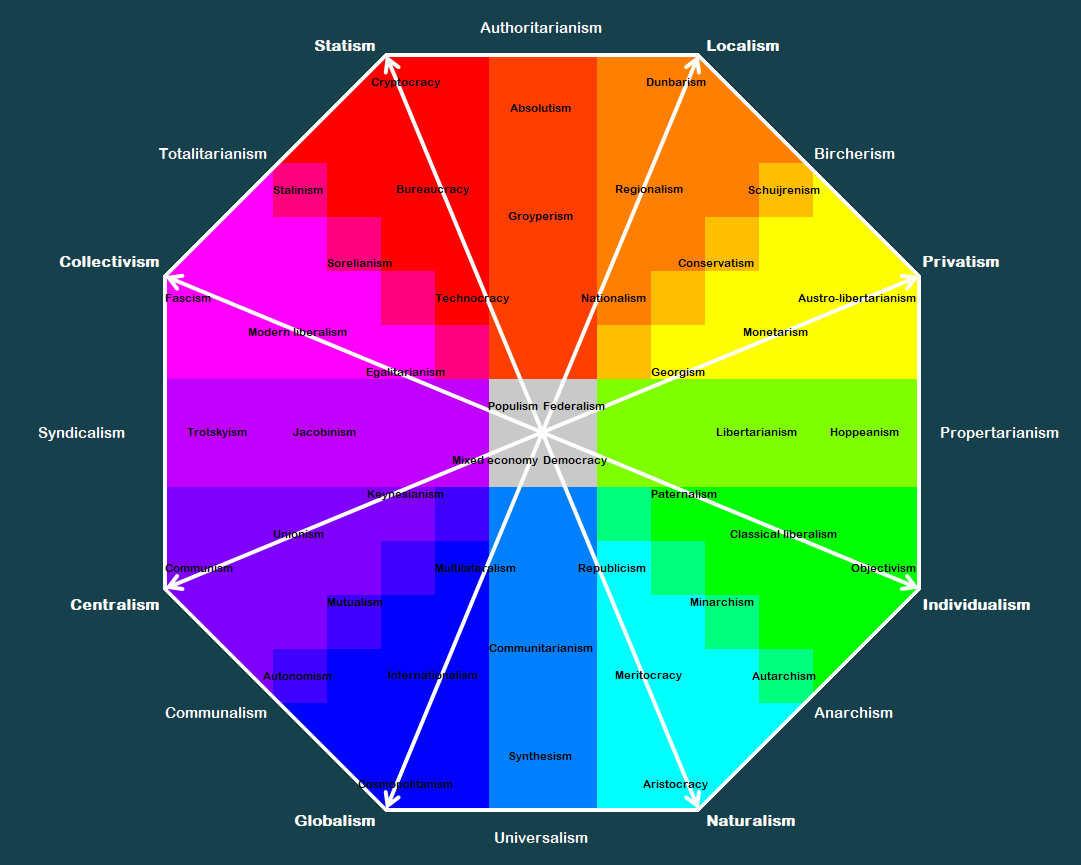
Cultural systems:
Dunbarism: the cultural system advocating for a local or Dunbar’s number-sized culture to be most significant.
Regionalism: the cultural system advocating for a regional or subnational culture to be most significant.
Nationalism: the cultural system advocating for a unique national culture to be most significant.
Federalism: the cultural system advocating for domestic similar cultures to be most significant.
Multilateralism: the cultural system advocating for a supranational culture including similar countries.
Internationalism: the cultural system advocating for a continental culture or relativist approach.
Cosmopolitanism: the cultural system advocating for a global or single culture to be most important.
Cultural-economical systems:
Schuijrenism: the cultural-economical system advocating for regional cultures and totally free markets.
Conservatism: the cultural-economical system advocating for cultural traditionalism and capitalism.
Mutualism: the cultural-economical system advocating for cultural relativism and wealth redistribution.
Autonomism: the cultural-economical system advocating for erasure of cultural decentralization and complete economic equality.
Economical systems:
Austro-libertarianism: the economical system advocating for total economic and financial freedom.
Monetarism: the economical system advocating for capitalism with limited government control.
Georgism: the economical system advocating for a single tax based on owned land and resources used.
Mixed economy: the economical system mixing elements of capitalist and socialist economical systems.
Keynesianism: the economical system advocating for government involvement in economic policy.
Unionism: the economical system advocating for unionized ownership of the means of production.
Communism: the economical system advocating for total wealth redistribution.
Economical-social systems:
Hoppeanism: the economical-social system advocating for total self-determination of private property.
Libertarianism: the economical-social system advocating for limited government intervention in the
economy and private life.
Jacobinism: the economical-social system advocating for force to bring socio-economic equality.
Trotskyism: the economical-social system advocating for permanent revolution to guarantee equality.
Social systems:
Objectivism: the social system advocating for the pursuit of self-interest as the highest moral value.
Classical liberalism: the social system advocating for unamendable individual liberty.
Paternalism: the social system advocating for incentive from the influential to the misfortunate.
Populism: the social system advocating for unity based on popular opinion with a shared interest.
Egalitarianism: the social system advocating for policies to secure social justice and equal outcomes.
Modern liberalism: the social system advocating for censorship or demonization to secure social justice.
Fascism: the social system advocating for violence, death or deportation to secure social justice.
Social-political systems:
Autarchism: the social-political system advocating for total self-governing with personal responsibility.
Minarchism: the social-political system advocating for a minimization of non-self-governing.
Sorelianism: the social-political system advocating for a powerful government to control and provide.
Stalinism: the social-political system advocating for the state to have total social and political control.
Political systems:
Aristocracy: the political system advocating for citizens with ability and expertise holding political power.
Meritocracy: the political system advocating for citizens with merit holding political power.
Republicism: the political system advocating for elected representatives holding political power.
Democracy: the political system advocating for each citizen to hold political power.
Technocracy: the political system advocating for technologic or scientific leaders to hold political power.
Bureaucracy: the political system advocating for an unelected but influential political power.
Cryptocracy: the political system advocating for an unknown or hidden political power.
Political-cultural systems:
Synthesism: the political-cultural system advocating for the merging of antithetical systems by reconciling common truths.
Communitarianism: the political-cultural system advocating for the community to merge different individual cultures for unity.
Groyperism: the political-cultural system advocating for the suppression of antithetical values.
Absolutism: the political-cultural system advocating for a divine, absolute authority.

An Ideology is formed by combining a political, economical, social and cultural system, or fused system. One example of an ideology is combining Dunbarism, Austro-libertarianism, Objectivism and Aristocracy.
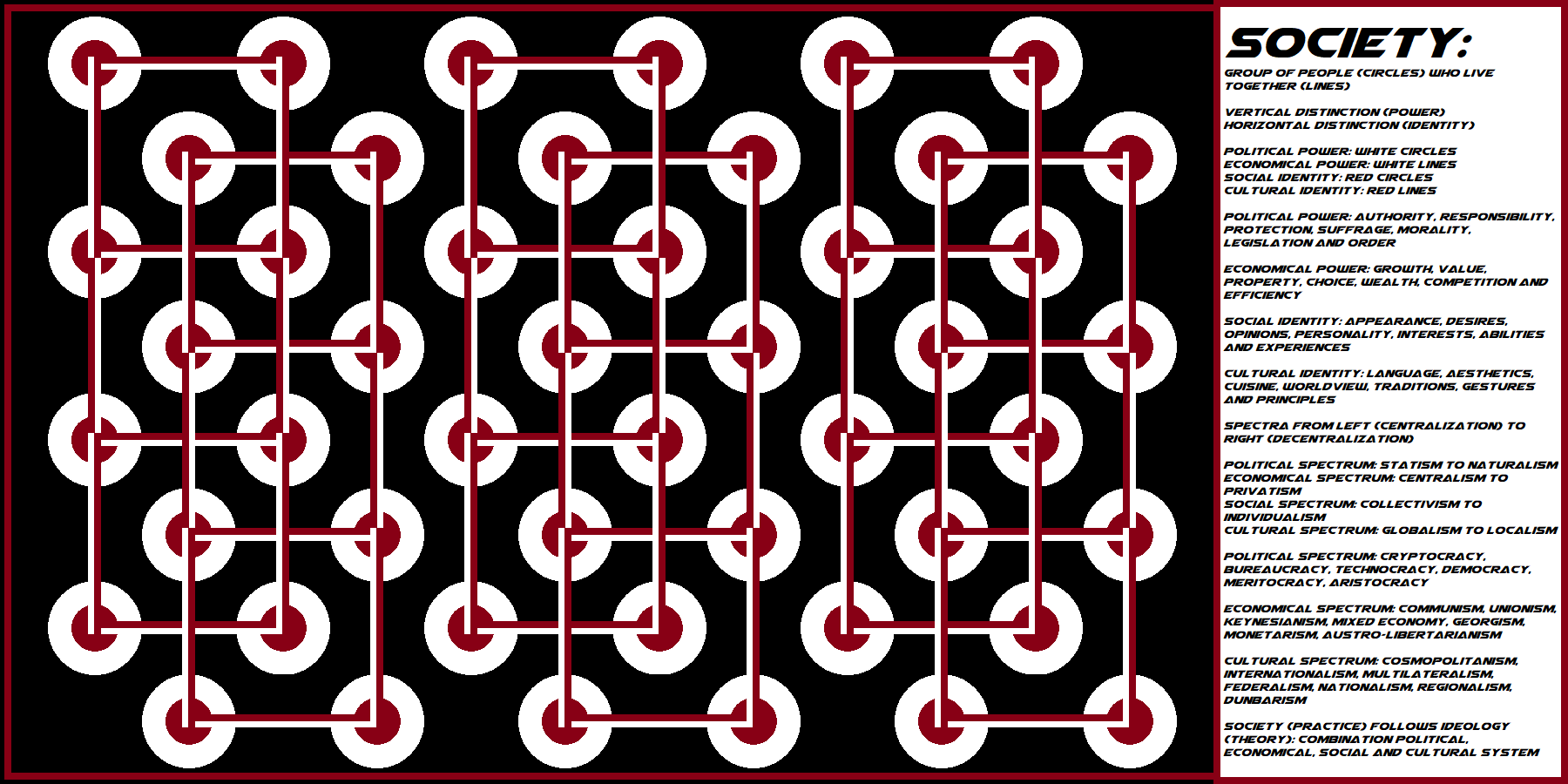
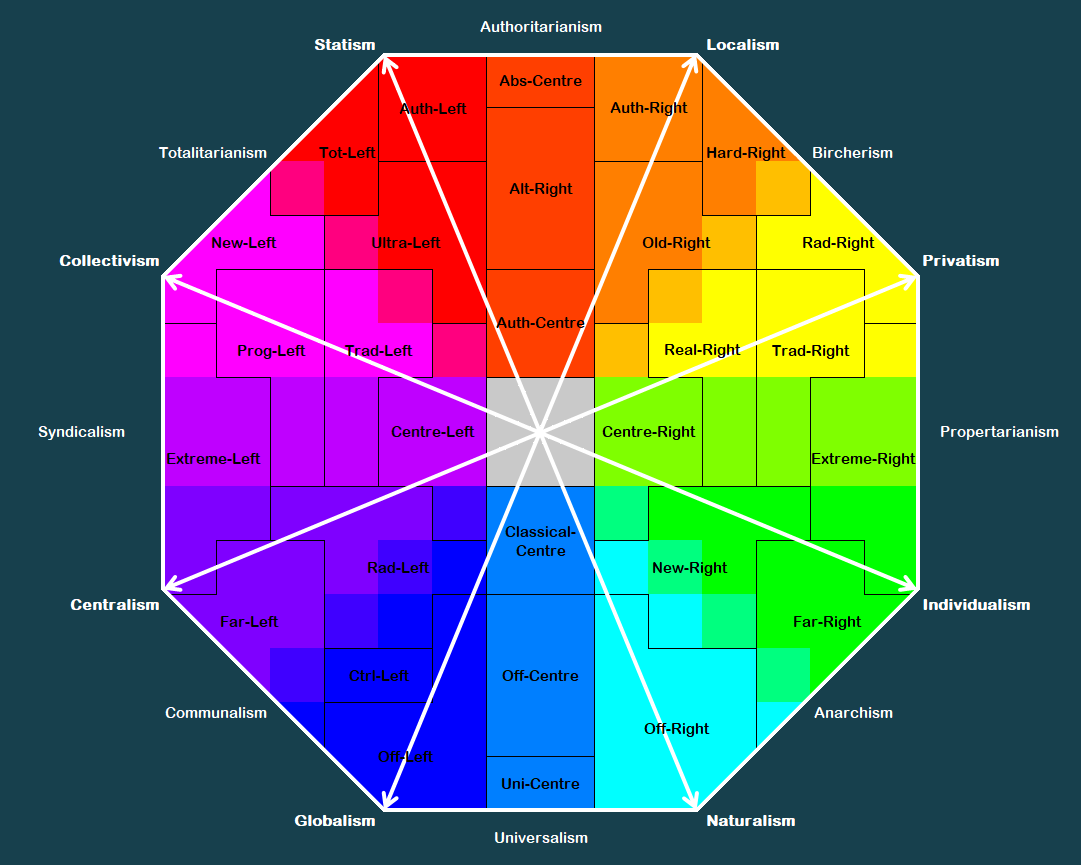
The LEFT-WING, CENTER-WING and RIGHT-WING are divided into alignments of each advocating for a collection of Leftist and Rightist values values to a different degree.
RIGHT-WING:
Auth-Right
For those that believe in the enforcement or advocacy of strict obedience to authority specifically in the
national security and interest i.e. strict adherence to law & order and constitutional rights, strong
military for national defense and a definitive foundation for the balance of the domestic economy. Even
though it is authoritarian it tends to reject the centralist platform for economics, as well as the political
collectivization of the individual, instead opting for the cultural unity of society under one premise.
Examples of such are a Military Junta, Agrarianism, Confederalism, Cameralism, Constitutional Monarchy, Salazar’s
New State (Second Republic) of Portugal, Pinochet’s Military Republic of Chile, Venizelos’ Second
Hellenic Republic in Greece, Bismarck’s German Empire and Donovanian Anarcho-Fascism.
Hard-Right
For those that believe in a (sub-)national unity as well as prolific determination in preservation of the
state's laws and principles, cultural values and the domestic free market. Tendency towards observing
ultraconservative principles and a highly formal perspective in civics and laws. Examples of such are Tea
Party, Timocracy, National Conservatism, Patriot Movement, Dominion Theology, High Tory, Hong Kong
Resurgence Order (Resurgencism) and Paleoconservatism.
Old-Right
For those who identify with the Rightwing position previous to the 20th century. Advocates for the
preservation of established institutions and traditional principles within the pre Post-Modern political
regime that referred to Conservative Loyalism or those adhering more so to Royalism. Examples of such
are Paleoconservatism, Integralism, Venizilism, Authoritarian Capitalism, High Tory, National
Conservatism, Constitutional Republicanism, Elective Monarchism, Confederalism and Parliamentarian Loyalism.
Rad-Right
Strong opposition to anything antithetical to the cultural ethos and interest of the nation, and the
security of the state, and principles/laws/rights constituted therein. Definitive opposition to any form of
Socialist doctrine that is politically organized. In favour of capitalist domination and republican
constitutionalism. Examples of such are Thatcherism, McCarthyism, John Birch Society, Classical
Republicanism, Korwinism, Radical Conservatism (Breitbart and von Mises), Nixonianism (New Federalism) and Nilssonian Anarcho-Fascism.
Real-Right
The midway of the Rightwave, this is the position of many new right-wingers and conservatives that
adhere to particularities from both traditional conservatism and direct policies of rightwing radicalism.
Upholding capitalism as the dominant economic system, conservative values in terms of rights, liberties
and laws, and classical liberal social principles as well as civic nationalism. Examples of such are
Trumpism, Reaganism, One Nation Toryism, Modern Republicanism, Federalism and Monetarism.
Trad-Right
For those that uphold social conservatism and traditional adherence to values/rights of classical
liberalism as well as conservative jurisprudence. Believing in a much more traditionalist approach in the
determination of laws and implementation of the constitution or in rights/liberties corresponding to
society. Examples of such are Traditional Conservatism, Fusionism, Monetarism and Constitutionalism.
Extreme-Right
For those of an extreme laissez-faire perspective advocating only minimal state intervention in the lives
of citizens, and uphold liberty as a core principle. Specifically adherent to the Austro-libertarian school
of socio-economics and political forms - the extreme of the traditional Rightwing adopts core aspects of
classical liberalism as well as the core values advocated by “liberal” economics. However, some can
relegate also towards the Authoritarian Right in specific cases. Examples of such are Libertarianism,
Paleolibertarianism, Hoppeanism, Rothbardianism, Austro-Libertarianism and Objectivism.
Center-Right
For those that retain a Liberalist or Democratic position to the Right (unlike modern day conservatism).
Adherent to the values and rights that are consistent within Western conservatism, but also socially,
economically or civically moderates open to ideas across the center. Examples of such are Republicans,
Directory Republicans, Whiggism, Georgism and Libertines.
New-Right
For those developing new movements within the Right as a reaction to the New Left, borrowing aspects
thereof in re-determining the parameters, often focused on elements of repurposing classical liberal
values, referring to classical traditionalism as well as transcending the ideals of liberal democracy and
republicanism towards more naturalized-communitarian philosophies. In response to Modern liberalism
these ideologies tend to navigate towards a platform that is mostly imbued with traditional or
communitarian values and anti-equalitarianism (identity politics or social equity). Also adopts a tertiary
model towards socio-economics that transgresses capitalism and rejects central planning, however
focuses on a mutually nurturing system that profits the overarching community of individuals - usually
adapting elements of Neo-Mercantilism, Traditional Communal Trade, Social Markets, and NationalCapital Syncretism. Examples of such are Goldwater Conservativism, Post-Conservatism, Fortuynism,
Meta-Right, Geo-libertarianism, National Anarchism, Minarchism, Renaissance Vanguardism, Classical
Liberalism, Neo-Libertarianism, National Coalitionism, and Neo-Integralism.
Far-Right
Those ideologies that advocate the elimination of centralized states in favor of self-ownership, private
property and free markets, belong to the furthest sphere of Rightwing values/principles thereby
representing more freedom instead of government overreach, more economic privatism instead of
economic centralism, more political individualism instead of political collectivism and more social
traditionalism instead of social progressivism. Although some tend to adopt a more archaic variant to
Capitalism, relegating back to barter and trade of mercantilist versions of exchange in the free market.
Examples of such are Anarcho-Capitalism, Pirate Movement, Geo-Anarchism, Classical Anarchy, Anarkhia, Agorism, Autarchism,
Individualist Anarchism and some extents of Egoism or Avaritionism.
Off-Right
Those ideologies that originated from the traditional Rightwing sphere but have transcended into the
Post-Modern Political Era. Most notably consisting of more communitarian and archaic economic
systems (that reject Socialism and transgress Capitalism) that reference older philosophical models,
principles and natural law. Complete rejection of positive law and (post-)modern society. Examples of
such are National Anarchism, Archeofuturism, Anarcho-Naturism (an off-shoot to self-reliance and
Naturism), Communitarianism, Natural Tribalism, Tribal Communitarianism, Traditional Primitivism,
Existential Anarchy and Anarcho-Primitivism.
CENTER-WING:
Abs-Center
For political systems previous to the Modern Political Era also referred to as Ancien Régime which
argues that one person should hold all power above all others who are subjugated. This includes an
autocratic ruler that is free of laws or legally organized opposition; especially in the period predating
1700. The nation-state does not exist, and all is conditional to the full authority (which upholds law,
economy/trade and society etc.) from one ruler by their "divine right". Some variations adopt anocratic
features combining the democratic or populist center and advocating for aspects of monarchist or
militarist junta-state structures. Examples of such are Total Autocracy, Absolutist Monarchy, Absolutist
Theocracy and Absolutist Oligarchy.
Alt-Right (Rad-Center)
For advocates of more authoritarian means to maintain values and identity, along with a left-right
balance of socio-economic policy, sometimes to the extent of bureaucratic processes and positive law to
reject anything deemed antithetical to the protected value system. Examples of such are the
Confederacy, Conservative Loyalism, National Conservatism, Carlism, Falangism, some variations of
Neoliberalism and the Groyper movement.
Auth-Center
For advocates of a relatively authoritarian or police state as a means to maintain to balance the degree
of social equality and a degree of social hierarchy, while opposing political changes which would result in
a significant shift of society strongly to either too much to the left or the right. It is also where the more
radical centrists would find themselves. Tendency to be open to views or policies from diverging political
positions of the moderate Left and the moderate Right concerning civics, laws and economics overall. Examples of such are Police State (Rechtsstaat) and Third Way.
Classical-Center
For advocates of a classical democracy (Athenian) as a means to support a balance of a degree of social
equality and a degree of social hierarchy, while opposing political changes which would result in a
significant shift of society strongly to either too much to the left or the right. It is also where the more
apolitical would find themselves. Centrism tends to be open to views or policies from diverging political
positions of the moderate Left and the moderate Right concerning civics, laws and economics overall. Examples of such are Athenian Democracy (Athenianism), Liquid Democracy and other variants of Direct Democracy.
Off-Center
For those advocating for some communitarian society that seeks the balance of left-wing and right-wing
policy primarily by pragmatism and synthesis of vastly different economical, social, value and belief
systems. Although the emphasis is put on conscious communitarian unity by democratic means.
Examples of such are different variations of communitarianism, meritocracy, few variations of synthesis
(meritocratic pragmatism), Internationalism and Post-Anarchism.
Uni-Center
For those advocating for a much more universal or communitarian approach, which favours for a
stylization that synthesizes the ideal of philosophical universalism. Universal principles and a mankinduniting consciousness, value system and belief system are primarily advocated for. Examples of such are
Synthesism, Universalism, Naturism, Post-Anarchism, Hippie movement and Political Pluralism.
LEFT-WING:
Auth-Left
For those that believe in the enforcement or advocacy of strict obedience to authority, specifically in the
security and interest of the state i.e. strict adherence to law & order and social liberties, strong military
for national defense and a definitive foundation for a centrally planned society for the public interest.
Tends to politically collectivize the nation, under one goal that is focused towards the precept of the
“common good”. Examples of such are cryptocratic means, intergovist (intergovernmentalist) structures
such as the European Union, and other authoritarian regimes from the left, such as Rodrigo Duterte’s
Social Republic of the Philippines, Colonel Gaddafi’s Libyan Arab Republic, Juan Perón’s Military Republic
of Argentina and Metaxas’ 4th of August Regime of Greece, Masonry, Austrofascism, Strasserism and Islamo-socialism.
Tot-Left
For those ideologies that advocate strongly for total statism or state control by means of a very
centralized government and authority of all assets, curbing individual determination and instead
advocating for a total consensus of the individual as a tool of the state. The nation thereby becomes a
product of the state and an intrinsic component by which the state inform the collective - this is why the
majority of such ideologies favor a “party” system that functions as the primary driving force of
collectively maintaining the totality of the state. The state replaces every aspect of the social contract,
and thereby becomes the substitute for everything and informs all. Examples of such are Stalinism,
Masonry, International Socialism, Jucheism, Orwellianism and some extent of Modern Charlemagne.
Ultra-Left
The dominion of the more hardline democratic-centric view of adopting aspects of social markets in a
more centralized fashion by enlisting a very large government influence upon the society overall,
thereby providing more public ownership by means of the state. Occurrence of a semi-elitist central and
powerful government providing all, with a centralized foreign policy and involvement. Examples of such
are Christian Democracy, Christian Socialism, Social Republic, Neoliberalism, Ordoliberalism, Traditional Socialism,
Classical and Orthodox Marxism, some extent of Neo-conservatism and Sorelianism.
New-Left
For those ideologies that have developed with the rise of the Post-Modern Political Era, and the fall of
the Cold War period during the mid-20th century to the Present-day - specific as a reaction to the
traditional Left. They often enforce democratic change without constraint pro-Socialist ideals in a much
more organized and syndicalism movement and structure. Focus is predominantly on the centralplanning of the nation-state overall (which can led to more government overreach for civil policies) as
well as a centralized economic plan that often influences outside the domestic sphere. Examples of such
are Nazism, National Socialism, Democratic Socialism, Mosleyism, Trotskyism (variants), Sociocracy, SocioCorporatism and some extent of Bolshevism and Fascism.
Trad-Left
For those that uphold societal liberalism and traditional adherence to values and rights of socialliberalism as well as an observance to progressive libertinism. Believing in a much more socialized
approach in the determination of laws and implementation of a democratic republic or the national
constitution or in rights and liberties corresponding to society, advocated of public ownership (protosocialists). Examples of such are Liberal socialism, Jacobinism, Modern Liberalism, Democraticism, Social
Liberalism and some extent of Mutualism.
Prog-Left
For those that adhere specifically to the Wilsonian School of Progressivism of the early 20th century -
promoting political collectivism in regards to central-planning, specifically in the cultural/societal
movement and radical theory of changing social policies by civil enforcement as well as socially adopting
radical and progressive new laws to shift the social consciousness and engineer a new cultural ethos.
Open to social-liberal ideals as well as revised Marxian socio-economics, advocates for economic change
that effectively address civil issues in both the domestic and foreign arena. Examples of such are
Progressivism (Wilsonian School), Fascism, Revisionist Marxism, Modern Liberalism, Radical Democracy,
Bolshevism, Social-Corporatism and some extent of the Labour movement.
Center-Left
Also referred to as moderate-left politics, are political views that lean to the left-wing on the left–right
political spectrum, but closer to the center than other left-wing politics. Tends to be advocate for liberal
economic policies but open to social markets and potentially other aspects of centralist planning within
the political structure and socio-economic sector. Most Moderate Leftists tend to be open towards
Social-Democracy and are often more so Democratic in their view of society. Examples of such are Blue
Dog Democrats, Liberal Democrats, Social Democracy, Democracy, Social Liberalism, Popular
Democracy, Liberal Socialism, the Nordic Model and some extent of Mensheviks.
Extreme-Left
For those of an extreme centralized and publicly socialized perspective advocating complete
government intervention in the lives of all citizens, so as to apply total egalitarian/equalitarian results -
and uphold principles of socialized liberties espoused by Marx. Specifically adherent to the ideals of the
Fabian Society and Frankfurt Critical Theory of social justice and identity politics - the extreme of the
traditional Leftwing adopts core aspects of social-liberalism and labor movements as well as unionism
(of the Liberalist movement) as well as the core values advocated by socialist/Marxian economics and
extreme syndicalist practice. However, the Extreme can often relegate also towards the Authoritarian
Left in specific cases, such as authoritarian democratic socialism. Examples of such are Trotskyism,
Labour Movement, some variations of Communism and Revisionist Marxism.
Rad-Left
Strong opposition to anything antithetical to the unitary planned revolution of Socialism as correlated to
Marx and early proponents of revolutionary socialist theory like Bakunin and the Second International,
as well as the eternal revolution adopting post-modern identity politics and cultural Marxist ideals.
Definitive opposition to any form of Republican doctrine and Capitalism. In favor of Socialist domination
and revolutionary socialist movements. Examples of such are Ochlocracy, Eco-Socialism, Radical
Distributism, some variants of Revolutionary Socialism, Social Liberalism and Mutualism.
Far-Left
Those ideologies that advocate the elimination of the regime or state by means of revolutionary socialist
methodology in favor of central-planned social equity, equalitarianism as well as public ownership of all
assets and class warfare within identity politics, they represent more communalist governing or public
owned centralization, more central-planning of all assets towards public ownership as opposed to free
markets, more political collectivism instead of political individualism and more social progressivism
instead of social traditionalism. Examples of such are Communism, Autonomism, Revolutionary
Socialism, Situationism, and Distributism.
Ctrl-Left
The reactionary Post-Modern movement of ideologies that are often times endorsed and sponsored by
special interests to activate violent or “revolutionary” social justice as well as radical Leftwing activism,
such as Black Lives Matter, ANTIFA, and other such inorganic movements that engage in attempting to
subvert and topple the status quo and regime. These types of movements tend to have been formed
from ideologues such as Bill Ayers and Saul Alinsky. Tendency to adopt revolutionary and violent tactics
masquerading as “anarchist” when in fact their sole purpose is to manifest riots and social discord.
Highly controlled and operated from special interests, wealthy lobbyists or foreign agents. Examples of such are Controlled Anarchy, Anarcho-Totalitarianism, some variations of Revolutionary Socialism and Controlled Distributism.
Off-Left
For those that have transcended into the Post-Modern Political Era most notably consisting of more
communalist and archaic economic Marxist systems (rejecting modern Socialism as well as Capitalism,
and transgress modern liberalism) that reference older philosophical models that prescribe to a new
insight on political social-liberalism and radical egalitarian values and principles. Cosmopolitan and
relativist approach to socio-cultural matters. Examples of such are Social Anarchy, Post-Anarchism,
Social Cosmopolitanism and Relativism, some variations of Communalism and Pan-Continentalism.
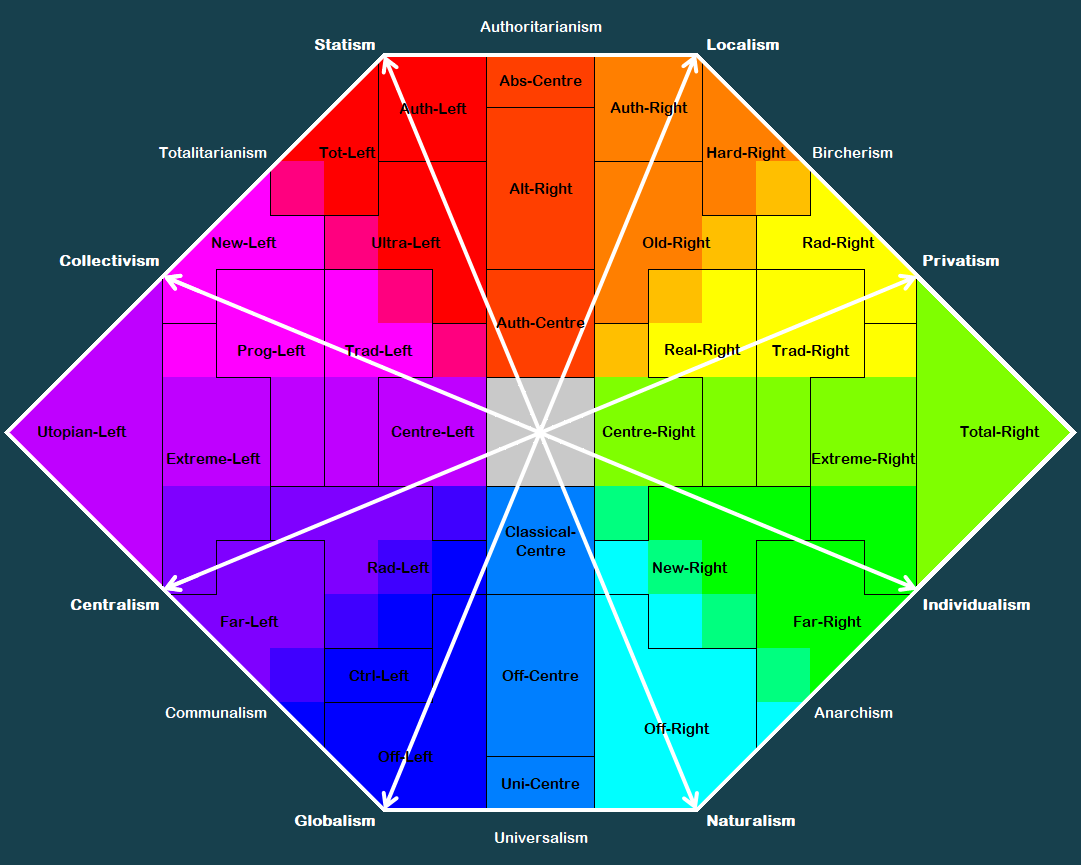
LEFT-WING and RIGHT-WING extensions outside of the conventional octagon, because of ideologies completely holding either all Leftist or Rightist structures thus emerging on ends of multiple pillars:
Total-Right
The Total-right is a 21st century right-wing movement that strives for the maximization of right-wing
decentralization, simply for the sake of it. It recognizes that as long as any form of leftism is present
within civilization, there's an incentive for subversion. When tribalism, austro-libertarianism, objectivism
and aristocracy are dominantly practiced, we can speak of a total-right society. The final form is
anarcho-radical propertarianism, where these maximally decentralized systems are practiced to the
fullest extent. Total-rightists recognize the fact that humanity is not politically equipped for the private
law society until at least another cycle of civilization, but through their extreme low time preference will
strive for a society realizable after their time. Examples of such are Radical Capitalism, Anarcho-Monarchism, Neocameralism, Post-Libertarianism and Anarcho-Radical Propertarianism.
Utopian-Left
The realization of a left-wing utopia. Society is considered post-scarce and may be under absolute
control of an unknown authority. Inequalities considered socially unjust between individuals and
differing cultural identities are erased. Examples of such are Brave New World’s World State, Utopian Socialism and Totalitarian-Communal Syndicalism.